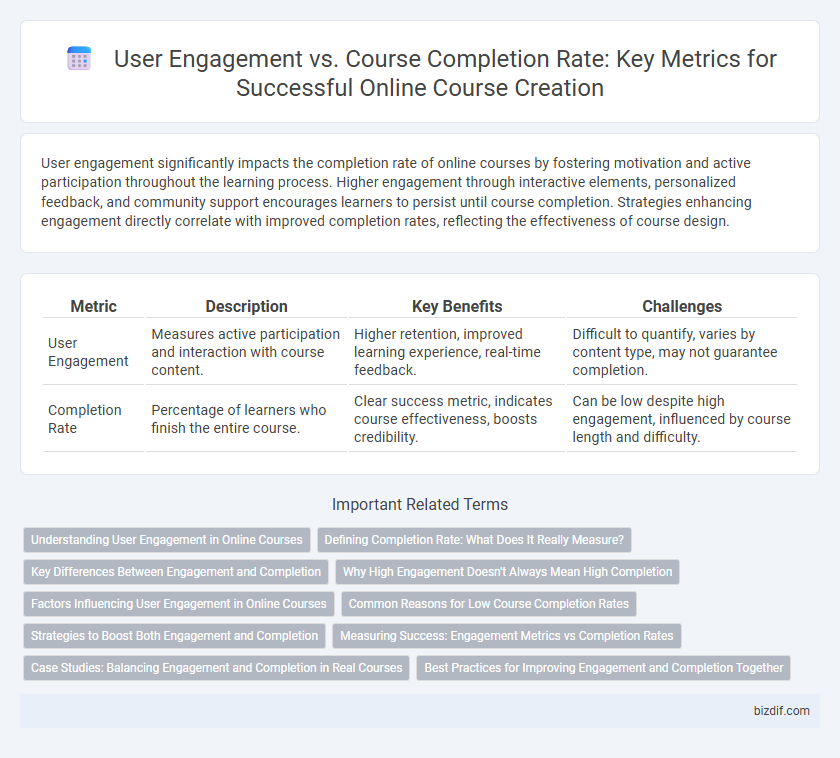User engagement significantly impacts the completion rate of online courses by fostering motivation and active participation throughout the learning process. Higher engagement through interactive elements, personalized feedback, and community support encourages learners to persist until course completion. Strategies enhancing engagement directly correlate with improved completion rates, reflecting the effectiveness of course design.
Table of Comparison
| Metric | Description | Key Benefits | Challenges |
|---|---|---|---|
| User Engagement | Measures active participation and interaction with course content. | Higher retention, improved learning experience, real-time feedback. | Difficult to quantify, varies by content type, may not guarantee completion. |
| Completion Rate | Percentage of learners who finish the entire course. | Clear success metric, indicates course effectiveness, boosts credibility. | Can be low despite high engagement, influenced by course length and difficulty. |
Understanding User Engagement in Online Courses
User engagement in online courses refers to the level of interaction and active participation learners exhibit throughout the course material. High user engagement often includes behaviors such as frequent logins, video watch time, quiz participation, and discussion forum activity, all of which are crucial indicators of learner commitment. Understanding these engagement metrics helps educators identify content effectiveness and optimize course design to improve overall completion rates.
Defining Completion Rate: What Does It Really Measure?
Completion rate measures the percentage of learners who finish an online course, offering insight into user commitment and course effectiveness. Unlike user engagement, which tracks interactions like video views and quiz attempts, completion rate specifically reflects learners reaching the course's end. It serves as a key performance indicator for evaluating content quality, pacing, and overall learner satisfaction in online course creation.
Key Differences Between Engagement and Completion
User engagement in online courses reflects how actively learners participate through interactions such as discussions, quizzes, and video views, whereas completion rate measures the percentage of students who finish the entire course. Engagement metrics provide insights into learner motivation and content appeal, while completion rates indicate overall course effectiveness and student persistence. Focusing on both metrics helps course creators optimize content delivery and improve learning outcomes.
Why High Engagement Doesn't Always Mean High Completion
High user engagement in online course creation often reflects active participation through discussions and resource downloads but does not guarantee course completion due to factors like course difficulty or time constraints. Completion rates are more strongly influenced by clear learning objectives, course pacing, and learner motivation than mere interaction levels. Understanding this distinction helps educators design courses that balance engaging content with achievable milestones to improve overall success.
Factors Influencing User Engagement in Online Courses
User engagement in online courses is heavily influenced by interactive content, personalized learning paths, and timely feedback, which all contribute to maintaining learners' motivation and interest. The design of multimedia elements, such as videos and quizzes, enhances attention and active participation, directly impacting how deeply users connect with the material. Factors such as course relevance, instructor presence, and social learning opportunities significantly determine the level of engagement and thereby influence overall course completion rates.
Common Reasons for Low Course Completion Rates
Low course completion rates often stem from limited user engagement due to lack of interactivity, unclear course objectives, and insufficient motivation techniques. Students frequently drop out when courses fail to hold their attention through dynamic content or personalized feedback. Addressing these issues with engaging multimedia, regular assessments, and community support can significantly improve both engagement and completion rates in online learning environments.
Strategies to Boost Both Engagement and Completion
In online course creation, boosting user engagement and completion rates requires interactive content such as quizzes, polls, and multimedia elements that maintain learner interest. Implementing personalized feedback and progress tracking motivates users by highlighting their achievements and areas for improvement. Offering flexible pacing and community support further enhances commitment, leading to higher course completion and overall satisfaction.
Measuring Success: Engagement Metrics vs Completion Rates
User engagement in online course creation reflects active participation through metrics like click rates, time spent, and interaction frequency, providing insights into learner involvement. Completion rates quantify the percentage of students finishing courses, indicating overall course effectiveness and learner motivation. Measuring success requires balancing these metrics, as high engagement may not always correlate with high completion, guiding instructional design improvements.
Case Studies: Balancing Engagement and Completion in Real Courses
Case studies in online course creation reveal that high user engagement does not always guarantee high completion rates; for example, interactive elements like quizzes and discussions increase activity but may overwhelm some learners, reducing completion. Successful courses balance engaging multimedia content with manageable pacing to maintain motivation throughout the curriculum. Data from platforms like Coursera and Udemy show that courses incorporating clear milestones and personalized feedback achieve both sustained engagement and higher completion rates.
Best Practices for Improving Engagement and Completion Together
Maximizing user engagement and completion rates in online course creation requires a blend of interactive content, personalized learning paths, and timely feedback to sustain learner motivation. Incorporating multimedia elements like videos, quizzes, and discussion forums fosters active participation, while clear milestones and progress tracking encourage consistent course advancement. Leveraging analytics to identify drop-off points enables targeted interventions, enhancing both engagement and the likelihood of course completion.
User engagement vs Completion rate Infographic

 bizdif.com
bizdif.com